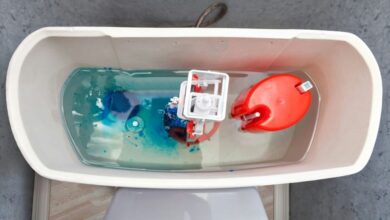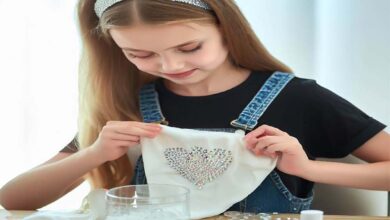Can You Dye Fabric With Acrylic Paint? Know Painting Secrets

Can You Dye Fabric With Acrylic Paint? Yes, it is possible to dye fabric with acrylic paint as it can effectively color and bond with fabric fibers. Acrylic paint serves as an alternative to traditional fabric dyes, offering a wide range of vibrant colors and easy accessibility.
By diluting the acrylic paint with water or a fabric medium, applying it to the fabric, and heat setting it, you can achieve a long-lasting and durable color on your fabric.
This method works best on natural fabrics such as cotton, linen, and silk, allowing you to customize and create unique designs on your fabrics. So, if you’re looking to add color to your fabrics, acrylic paint can be a suitable option.
Can You Dye Fabric With Acrylic Paint?
Yes, it is possible to dye fabric with acrylic paint, but it’s important to note that this method is more accurately described as painting or “hand-painting” fabric rather than traditional dyeing.
Acrylic paint is not a traditional fabric dye, but it can be used to add color to fabric in a creative and artistic way.
How To Dye Fabric With Acrylic Paints?

Here’s a step-by-step guide on how to paint fabric with acrylic paint:
Choose the right fabric:
Acrylic paint works best on natural fibers, such as cotton, linen, and canvas. Synthetic fabrics may not absorb the paint as well and may not yield the desired results.
Prepare the fabric:
Wash and dry the fabric before painting to remove any sizing or impurities that might interfere with paint absorption.
Mix the paint:
Acrylic paint is typically quite thick, so you may need to dilute it slightly with water or a fabric medium to make it more suitable for fabric application. Follow the instructions on the fabric medium bottle for the correct ratio.
Test on a swatch:
Before applying paint to the entire fabric, do a small test on a swatch or an inconspicuous area to ensure that the paint adheres well and achieves the desired effect.
Painting process:
Lay the fabric flat on a protected surface and start painting with acrylic paint. You can use brushes or sponges to apply the paint. Be creative with your design and color choices.
Let it dry:
Once you’ve finished painting, let the fabric dry completely. Depending on the thickness of the paint and environmental conditions, this may take a few hours to overnight.
Heat setting (optional):
To improve the paint’s washability and durability, heat setting is recommended. Iron the painted fabric on the reverse side (with a pressing cloth or parchment paper between the iron and fabric) or use a fabric-specific heat-setting method as directed by the fabric medium or acrylic paint manufacturer.
Wash and care:
Hand wash the painted fabric gently in cold water with mild detergent. Avoid using harsh chemicals or bleach. It’s best to avoid machine washing or harsh agitation to preserve the painted design.
Keep in mind that while acrylic paint can be used to create beautiful and unique designs on fabric, it may not be as permanent or colorfast as traditional fabric dyes.
The painted fabric may require more delicate handling and care to maintain its appearance over time.
For visual understanding about how to dye clothes with acrylic paint, watch the video.
Exploring Different Dyeing Techniques With Acrylic Paint
Are you looking to add a splash of color to your plain fabric? If so, you might be wondering if you can use acrylic paint. Acrylic paint is primarily used for painting on surfaces like canvas, but it can also be utilized for fabric dyeing.
Here, we will explore different dyeing techniques that you can try using acrylic paint.
Sponging Technique For A Soft And Textured Effect
If you desire a soft and textured effect on your fabric, the sponging technique can help you achieve it. Here are the key points to keep in mind:
- Dampen a sponge with water and wring out any excess moisture.
- Apply acrylic paint directly onto the sponge, ensuring it absorbs evenly.
- Dab the painted sponge gently onto your fabric, allowing the paint to transfer in a soft and textured manner.
- Experiment with different colors and overlapping techniques to create unique patterns and effects.
Brushing Technique For A Controlled And Detailed Design
For a more controlled and detailed design on your fabric, the brushing technique is a great option. Here’s what you need to know:
- Choose a suitable brush size and shape for the design you want to create.
- Apply acrylic paint directly to the brush and make sure it is evenly distributed.
- Use short strokes or delicate brush movements to create the desired design or pattern.
- Layer different colors to add depth and dimension to your fabric.
Dip-Dyeing Technique For Gradient And Ombre Effects
If you’re aiming for gradient or ombre effects on your fabric, the dip-dyeing technique with acrylic paint is perfect. Follow these steps:
- Prepare multiple containers of water, each with a different dilution of acrylic paint.
- Dip different sections of your fabric into the containers, starting from the lightest color to the darkest.
- Allow the fabric to soak in each container for a specific duration to achieve the desired color intensity.
- Gradually lift the fabric out of each container, allowing any excess paint to drip off.
- Rinse the fabric thoroughly with clean water and let it dry to set the colors.
Give these techniques a try and let your creativity flow. Acrylic paint offers endless possibilities for dyeing fabric, whether you want a soft and textured effect, a controlled and detailed design, or gradient and ombre effects.
Experiment with different techniques, colors, and patterns to create one-of-a-kind fabrics that truly stand out.
Happy fabric dyeing.
Proper Care And Maintenance Of Dyed Fabrics
To extend the life of your newly dyed fabric and maintain its vibrant colors, it’s important to follow proper care and maintenance practices. Here are a few guidelines to consider:
- Wait for curing: Allow the paint to fully cure on the fabric for at least 24-48 hours before washing or using the item. This will help the paint bond better with the fibers.
- Handwashing: It is generally best to handwash dyed fabrics with mild detergent and cold water. This helps prevent fading and damage to the painted design.
- Gentle cycle: If you prefer using a washing machine, select the gentle cycle with cold water and a mild detergent to protect the dyed fabric from excessive agitation.
- Air drying: Avoid using a dryer as the high heat can cause the paint to crack or fade. Instead, hang the fabric to air dry or lay it flat on a drying rack.
- Ironing precautions: When ironing the dyed fabric, use a low heat setting and place a cloth or parchment paper over it to prevent direct contact between the iron and paint.
By following these heat setting techniques and caring for your dyed fabric correctly, you can enjoy long-lasting, vibrant results.
With a little creativity and attention to detail, acrylic paint can be a fantastic option for dyeing fabric and transforming your textiles into unique works of art.
Benefits Of Using Acrylic Paint For Transforming Fabrics

When it comes to transforming fabrics, acrylic paint has several advantages that make it a top choice for diy fabric dyeing. Let’s take a closer look at the benefits it brings:
Easy accessibility:
Acrylic paint is widely available in art supply stores and online, making it easily accessible for anyone interested in fabric dyeing projects.
Cost-effective:
Compared to specialized fabric dyes, acrylic paint is a budget-friendly option. You can use the same acrylic paint set you have for other art projects, minimizing the need to invest in additional materials.
Customizability:
With acrylic paint, you have the freedom to customize the colors and patterns according to your preferences and project requirements.
You are not limited to pre-made dye colors, allowing for more personalization in your fabric transformations.
Versatile application:
Acrylic paint can be applied to fabrics through various techniques, as mentioned earlier. This flexibility enables you to achieve different visual effects and experiment with different styles.
Beginner-friendly:
If you are new to fabric dyeing or painting, acrylic paint is a beginner-friendly option. Its water-based nature and ease of use make it suitable for those who are just starting their creative journey with fabric transformations.
Quick drying time:
Acrylic paint dries relatively fast, allowing you to complete your fabric dyeing projects in a shorter amount of time. This means less waiting and more enjoying your newly transformed fabrics.
Acrylic paint offers a versatile and cost-effective solution for dyeing fabrics. Its wide range of colors, durability, and ease of use make it an excellent choice for transforming clothing, home decor, and other fabric items.
Whether you are an experienced artist or a beginner, acrylic paint opens up a world of creative possibilities for adding perso
Troubleshooting Tips And Common Mistakes To Avoid
Dyeing fabric with acrylic paint can be a creative and cost-effective way to personalize your textiles. However, this diy method comes with its own set of challenges.
To help you achieve the best results, we’ve outlined some common difficulties you may encounter when dyeing fabric with acrylic paint:
- Uneven color distribution: Acrylic paint has a thicker consistency compared to traditional fabric dyes. This can result in uneven color distribution on your fabric. To avoid this issue, consider diluting the acrylic paint with water or a fabric medium to achieve a more fluid consistency.
- Paint absorption: Some fabrics, like polyester or nylon, may not readily absorb acrylic paint. This can lead to a faded or washed-out appearance. To improve paint absorption, pre-treat the fabric with a fabric medium or use a porous fabric such as cotton or linen for better results.
- Paint bleeding: Acrylic paint can bleed or spread beyond the intended areas on the fabric. To prevent this, ensure that your fabric is properly secured and stretched taut. Use painter’s tape or a resist medium to create boundaries and prevent the paint from bleeding.
- Paint cracking or peeling: When acrylic paint dries on fabric, it can become stiff and prone to cracking or peeling. To minimize this issue, consider adding a fabric medium to the paint mixture. This will enhance flexibility and durability, preventing cracking or peeling after drying.
Remember, practice makes perfect. Don’t get discouraged if your first attempts at acrylic paint fabric dyeing don’t turn out as expected. With time, patience, and the right techniques, you’ll be able to create stunning and unique designs on fabric using acrylic paint.
Final Thoughts
Dyeing fabric with acrylic paint is an innovative and cost-effective method that allows for endless possibilities in creating unique and personalized designs.
The versatility of acrylic paint makes it a popular choice among crafters and diy enthusiasts. With proper techniques and materials, it is possible to achieve vibrant and long-lasting colors on various types of fabric.
However, it is important to keep in mind that acrylic paint may alter the texture of the fabric and affect its breathability. Preparing the fabric correctly and fixing the colors with heat or an acrylic medium can help maintain the integrity of the fabric.
While there may be limitations and challenges, experimenting with acrylic paint as a fabric dye can open up a world of creativity and exploration.
So go ahead and give it a try – you may be pleasantly surprised by the beautiful results you can achieve.
Read More:



